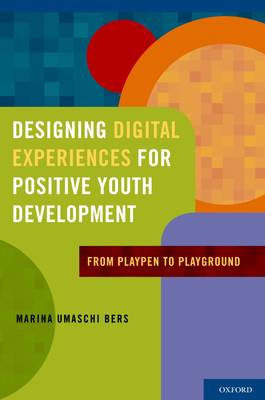
- Retrait gratuit dans votre magasin Club
- 7.000.000 titres dans notre catalogue
- Payer en toute sécurité
- Toujours un magasin près de chez vous
- Retrait gratuit dans votre magasin Club
- 7.000.0000 titres dans notre catalogue
- Payer en toute sécurité
- Toujours un magasin près de chez vous
Designing Digital Experiences for Positive Youth Development
From Playpen to Playground
Marina Umaschi Bers
Livre relié | Anglais
157,95 €
+ 315 points
Description
With the advent of the digital age, research on the psychological impact of youth engagement with technology has surged. New technologies have often taken the blame for promoting negative (and potentially dangerous) youth experiences, such as cyber-bullying, sexual predation, privacy invasion, addiction to videogames, and exposure to violence. For many children and adolescents, however, digital media and technology provide positive ways to express identity, communicate with peers, and engage in civic activities across communities. Based on over a decade and a half of research, Designing Digital Experiences for Positive Youth Development aims to guide readers in the design of digital technologies to promote positive behaviors in children and teenagers. Highlighting the positive impact of new technologies in various domains across the developmental span, from early childhood to late adolescence, the book explores how young people are using technology today, how these experiences influence different age groups and domains, and how mastering technological literacy can lead to confidence, competence, and developmental growth. Following this exploration, the author presents her own theoretical framework (coined Positive Technological Development, or PTD) for designing and evaluating programs to support children and teenager's positive uses of technology. Each chapter is supplemented with vignettes describing, from a developmental perspective, the diverse experiences of today's youth with current technology. Case studies are then presented that illustrate how PTD has effectively informed the design of educational programs. Offering a fresh perspective that bridges digital media and youth development models, this book will be an important resource for educators, policy makers, mental health professionals, as well as researchers interested in child development, psychology and learning technologies.
Spécifications
Parties prenantes
- Auteur(s) :
- Editeur:
Contenu
- Nombre de pages :
- 216
- Langue:
- Anglais
Caractéristiques
- EAN:
- 9780199757022
- Date de parution :
- 02-03-12
- Format:
- Livre relié
- Format numérique:
- Genaaid
- Dimensions :
- 155 mm x 239 mm
- Poids :
- 453 g

Les avis
Nous publions uniquement les avis qui respectent les conditions requises. Consultez nos conditions pour les avis.






